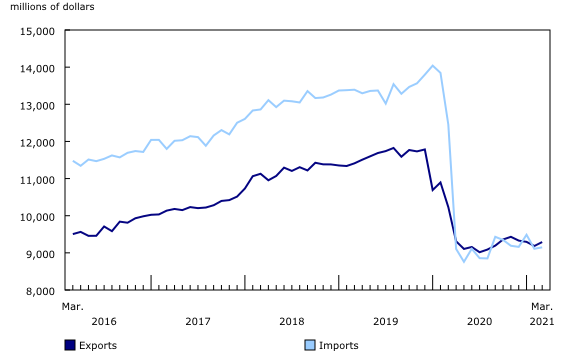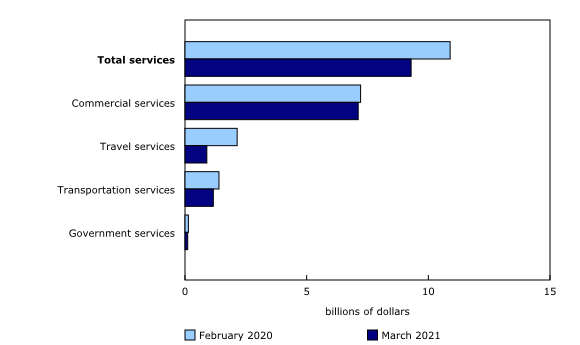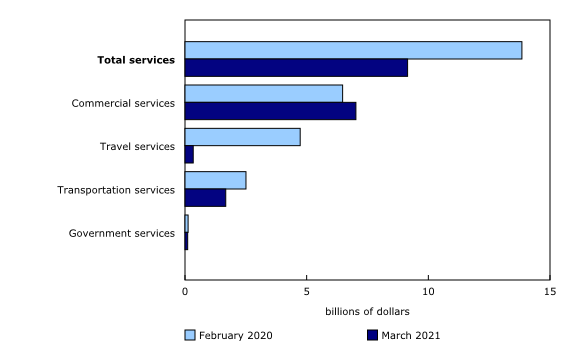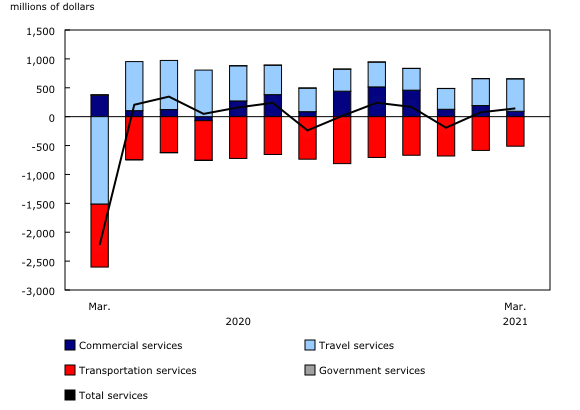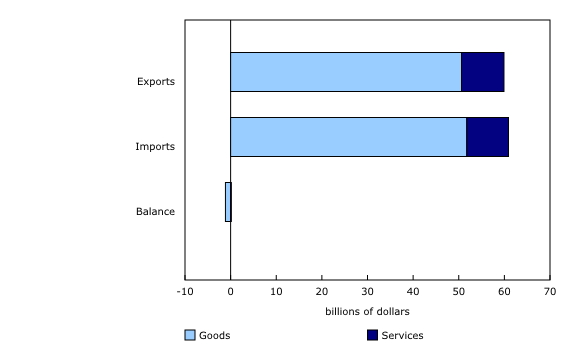Canadian international trade in services, March 2021
Archived Content
Information identified as archived is provided for reference, research or recordkeeping purposes. It is not subject to the Government of Canada Web Standards and has not been altered or updated since it was archived. Please "contact us" to request a format other than those available.
Released: 2021-05-04
Canada's monthly international trade-in-services surplus increased from $75 million in February to $143 million in March, mainly because of lower imports of travel services and transportation services. Overall, exports of services rose 1.2% to $9.3 billion, and imports were up 0.4% to $9.1 billion.
Exports of commercial services increased 1.4% to $7.1 billion in March, led by higher exports of financial services, mainly in the form of commissions. Exports of transportation services rose 1.9% to $1.2 billion, while exports of travel services declined 1.9% to $898 million.
Imports of commercial services were up 2.9% to $7.0 billion in March. As with exports, this increase was mainly attributable to financial services, in the form of commissions. Imports of transportation services were down 3.0% to $1.7 billion.
Imports of travel services fell $111 million to $338 million in March, the lowest level since May 2020, following a large decline in February. Before these two monthly declines, imports of travel services had increased in every month from the low in May 2020 to January 2021. The decrease in travel services in March reflects a second consecutive monthly decline in the number of Canadians returning from abroad, as more stringent COVID-19 testing and quarantine regulations for Canadian-resident travellers returning to Canada were announced and came into effect in February.
By comparison, total imports of goods increased 5.5% to $51.8 billion in March, and total exports of goods were up 0.3% to $50.6 billion, resulting in a goods deficit of $1.1 billion. Combined, the trade balance for goods and services amounted to a $1.1 billion deficit in March—a $2.6 billion change from a surplus of $1.4 billion in February.
The services trade surplus for February, first reported at $79 million, was revised down to $75 million with this month's release. Imports of services for February were revised up by $44 million, following upward revisions to commercial services and transportation services. Exports of services were revised up by $40 million, mainly because of upward revisions to commercial services.
Note to readers
Travel services and related services
In light of travel restrictions and border closures related to the COVID-19 pandemic, atypical values for travel services not related to education and for the passenger fares component of transportation services were reported for most of 2020.
To publish consistent estimates of seasonally adjusted values, seasonal factors from 2019 were applied to the unadjusted data for 2020. While using 2019 factors allowed for a certain amount of coherence and consistency in the seasonally adjusted estimates, it resulted in a larger-than-usual discrepancy between the annual totals for the seasonally adjusted series and the unadjusted series that must be reconciled at the end of the year, as is common practice.
As a result, this reconciliation created a substantial decrease in exports from December 2019 to January 2020. Data for 2019 will be open for revisions in the fall of 2021, and seasonal adjustment models may be revised at that time.
Under more typical seasonal patterns, this decline would not have been as large. Users are advised to use caution when analyzing month-over-month movements for seasonally adjusted exports for the two series, especially during this period, and may wish to include unadjusted data in their analysis.
Adjustments to the methodological approach
Circumstances surrounding COVID-19 pose issues for the production of monthly international trade-in-services statistics, particularly for travel and transportation services.
Travel services and the passenger fares component of transportation services are estimated using tourist and traveller counts as indicators of monthly movement. These data are not available on a timely basis and are projected for the reference month, before being replaced with the actual values the following month. This approach works in a typical month but does not work in the current situation, in which travel restrictions to reduce tourist and traveller numbers were implemented very quickly.
To better capture the effects of the COVID-19 pandemic, Statistics Canada is incorporating data from the Canada Border Services Agency's primary inspection kiosks into its monthly international trade-in-services program. These are electronic customs declaration kiosks that have been installed in most major Canadian airports. While these data represent only a subset of total travellers, they provide relevant and timely insights.
In addition, the methodology used to estimate the monthly international trade-in-services statistics involves first projecting quarterly benchmark values, then dividing these quarterly values into monthly values using economic indicators. While the projected quarterly value was previously kept constant throughout the production process for all three months of the quarter, with the current volatility, this particular element of the model was revised, and the benchmark values are being adjusted as needed based on the most current data.
Methodology
Because several data sources used to compile the data from the international trade-in-services program are available on a quarterly or annual basis only, the monthly statistics on Canada's international trade in services are generated using models when up-to-date information is not available. This follows the methodology used in many countries that produce monthly trade-in- services data.
In general, for most commercial and travel services, as well as some transportation services, modelling of monthly estimates follows a three-step approach. First, values for the upcoming quarter are estimated using statistical models (auto-regressive-integrated moving average). Second, indicator series that act as a proxy for the monthly movement of trade in services are identified through relationships with other economic indicators such as merchandise trade or gross domestic product by industry. Third, a temporal disaggregation method (the Denton–Cholette method) is applied to distribute modelled quarterly services on a monthly basis, using the predicted values of monthly services generated in the second step. Adjustments are made each month as new information becomes available.
Products
The updated Canada and the World Statistics Hub (13-609-X) is available online. It illustrates the nature and extent of Canada's economic and financial relationship with the world using interactive charts and tables. This product provides easy access to information on trade, investment, employment and travel between Canada and a number of countries, including the United States, the United Kingdom, Mexico, China, Japan, Belgium, Italy, the Netherlands and Spain.
The Methodological Guide: Canadian System of Macroeconomic Accounts (13-607-X) is available.
The User Guide: Canadian System of Macroeconomic Accounts (13-606-G) is also available. This publication will be updated to maintain its relevance.
Contact information
For more information, contact us (toll-free 1-800-263-1136; 514-283-8300; STATCAN.infostats-infostats.STATCAN@canada.ca).
To enquire about the concepts, methods or data quality of this release, contact Alec Forbes (613-668-6454; alec.forbes@canada.ca), International Accounts and Trade Division.
- Date modified:



